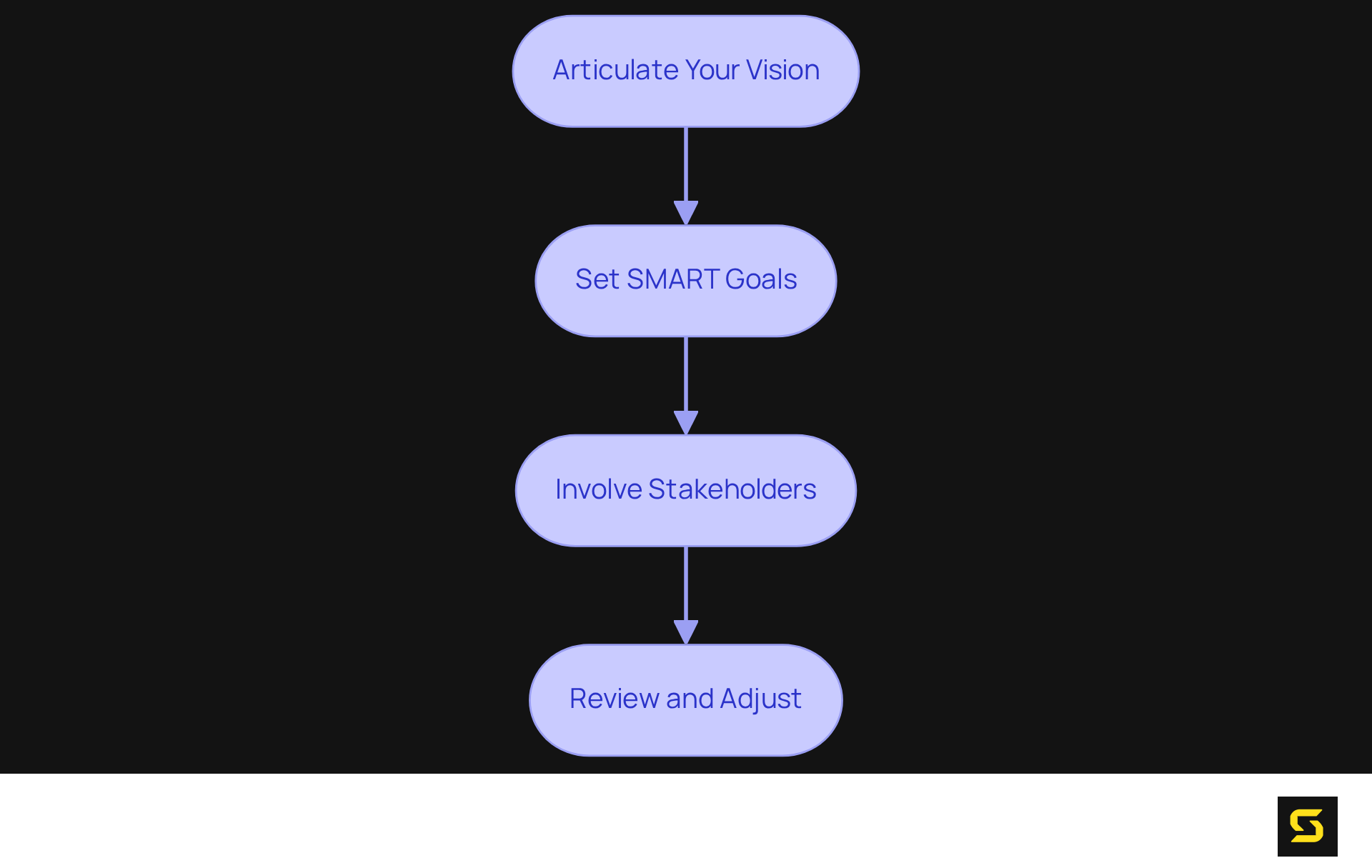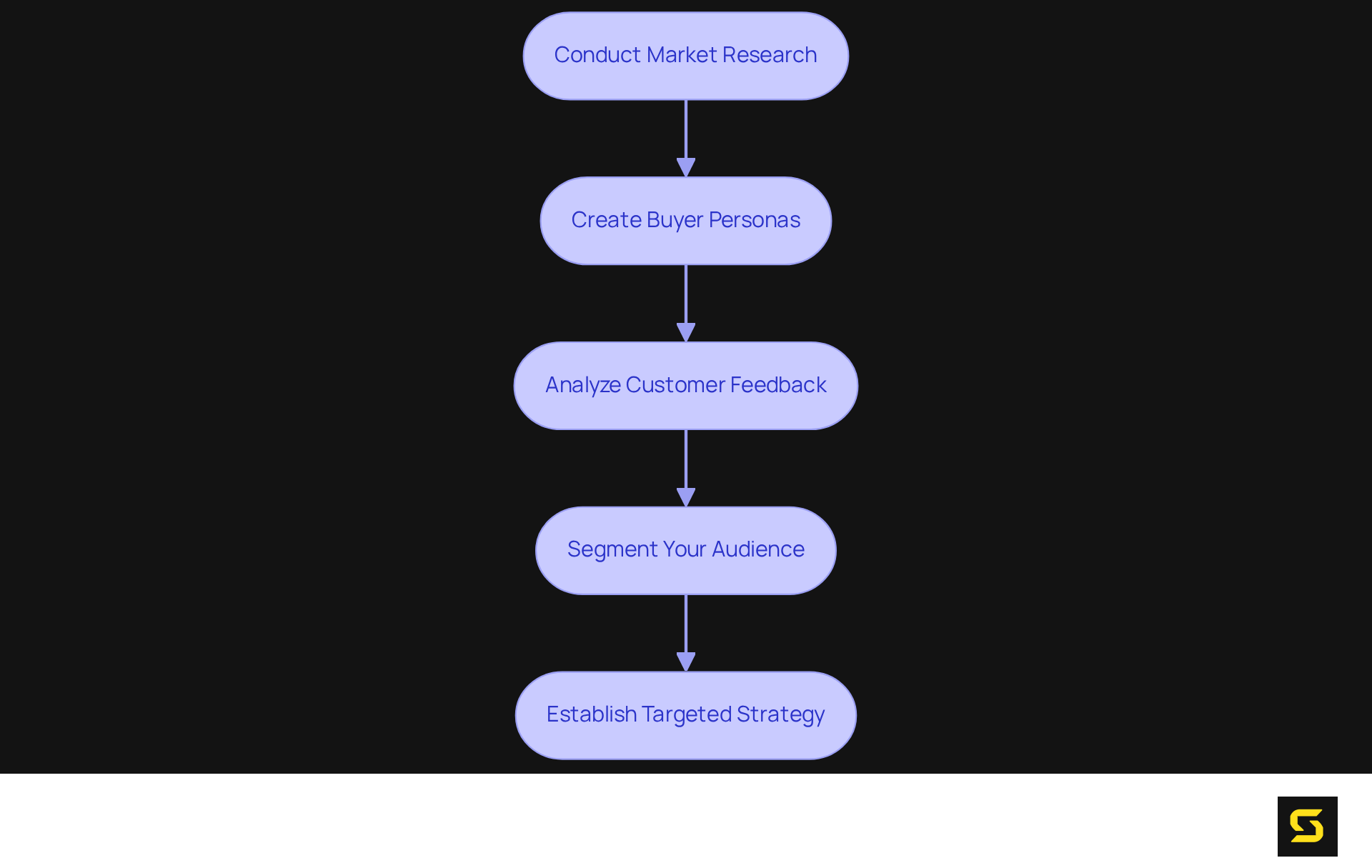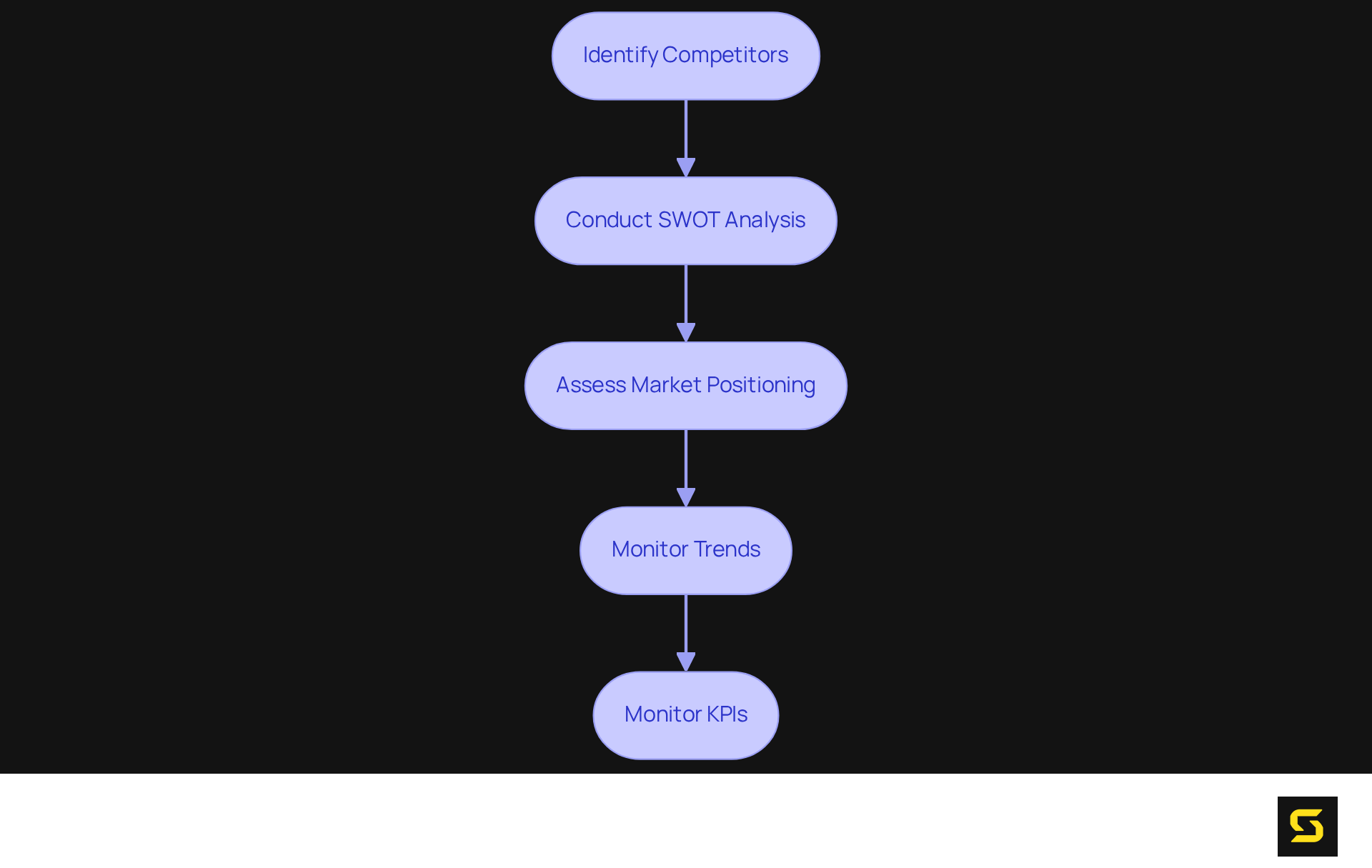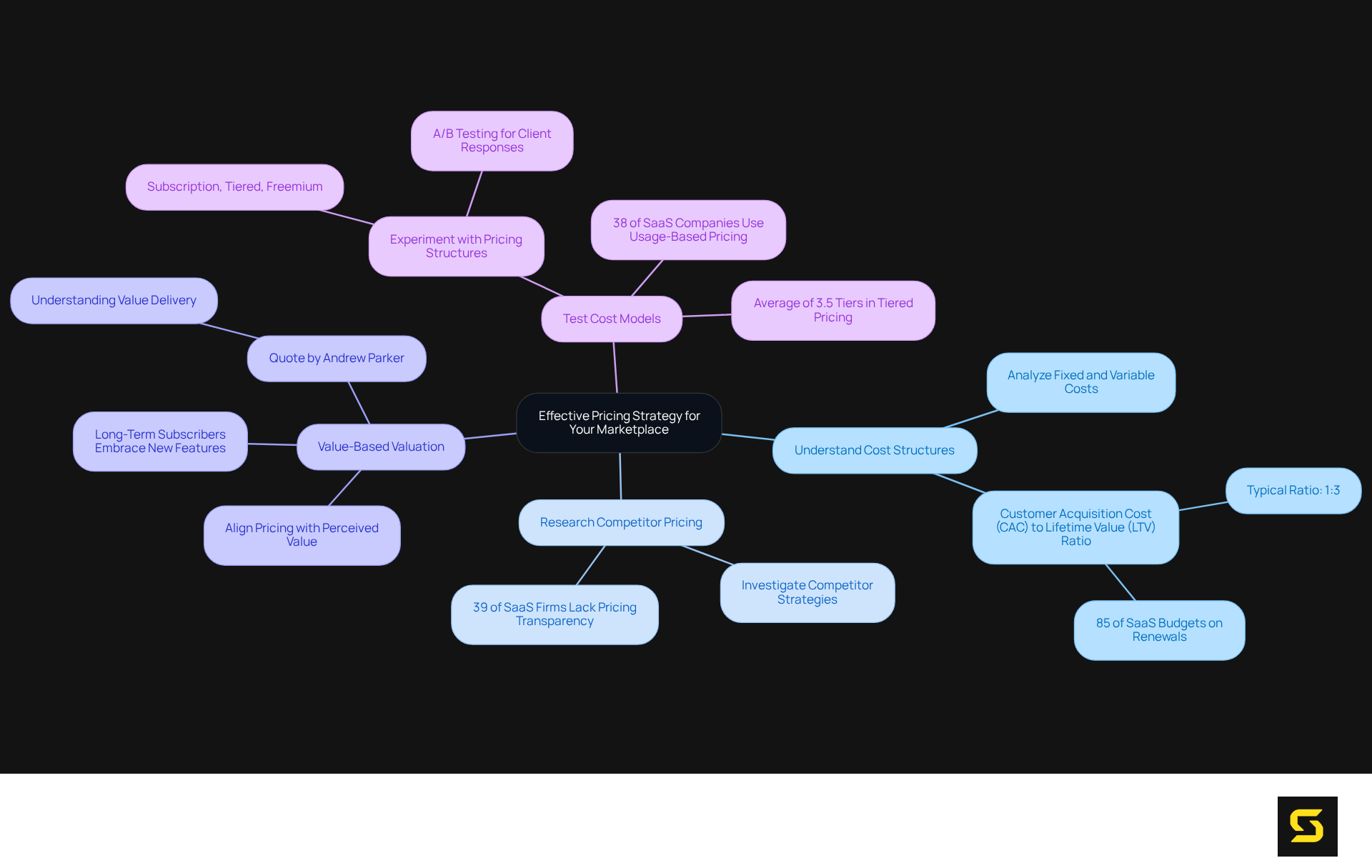Overview
To develop an effective marketplace strategy, one must follow four essential steps:
- Define a clear vision and goals.
- Identify the target audience and their needs.
- Analyze market competition.
- Choose an effective pricing strategy.
Each of these steps is bolstered by practical methodologies, including:
- Conducting market research.
- Engaging stakeholders.
- Leveraging competitive analysis.
These methodologies collectively enhance the strategic positioning and operational success of a marketplace. Embracing these steps will not only position your marketplace for success but also ensure that it meets the evolving demands of the market.
Introduction
Crafting a successful marketplace strategy is not merely a trend; it is an essential requirement for businesses striving to excel in a competitive landscape. By concentrating on pivotal elements such as vision, audience understanding, market analysis, and pricing, organizations can unlock the potential for sustainable growth and enhanced customer engagement. Yet, the challenge persists: how can businesses adeptly navigate these intricate components to not only meet but surpass their marketplace objectives? This article explores four fundamental steps that can elevate a marketplace strategy from a nebulous idea into a robust blueprint for success.
Define Your Marketplace Vision and Goals
To effectively define your marketplace vision and goals, begin by articulating your long-term aspirations. A compelling vision statement serves as a guiding light, inspiring your team and aligning efforts toward a common purpose. Consider the following steps:
- Articulate Your Vision: Craft a clear and concise vision statement that encapsulates your marketplace's purpose and aspirations. This statement should not only inspire but also provide direction for your team.
- Set SMART Goals: Establish goals that are Specific, Measurable, Achievable, Relevant, and Time-bound. For instance, aim to boost user engagement by 30% within the next year, ensuring that your objectives are grounded in reality.
- Involve Stakeholders: Engage key stakeholders in the goal-setting process to foster buy-in and alignment across the organization. This enhances commitment and ensures that diverse perspectives are considered.
- Review and Adjust: Regularly revisit your vision and goals to adapt to industry changes and organizational growth. Flexibility is essential for long-term success, allowing you to pivot as necessary to meet evolving demands.
Statistics indicate that organizations with a clear vision statement are significantly more likely to achieve their goals, with studies showing that effective vision integration can explain up to 40% of employees' creative performance. As Simon Sinek aptly puts it, 'Vision is a destination - a fixed point to which we focus all effort.' Furthermore, as Seneca the Younger wisely stated, 'If one does not know to which port one is sailing, no wind is favorable.' By embedding a strong vision into your marketplace strategy and ensuring it is integrated into employees' daily work roles, you not only enhance operational efficiency but also position your organization for sustainable growth.

Identify Your Target Audience and Their Needs
To effectively identify your target audience and their needs, consider the following steps:
- Conduct Market Research: Leverage a combination of surveys, interviews, and focus groups to gather comprehensive data on potential users. Examining current industry reports can uncover essential trends and preferences that guide your marketplace strategy. As Erico Fileno observes, "With stricter regulations like GDPR and CCPA, companies are now required to prioritize data ethics and compliance," highlighting the significance of ethical data gathering in research.
- Create Buyer Personas: Develop detailed profiles of your ideal customers, encompassing demographics, interests, and challenges. This visualization aids in designing products that resonate with your target audience. By 2025, AI-driven surveys and predictive analytics are anticipated to greatly reduce operational expenses in research, enhancing persona development efficiency.
- Analyze Customer Feedback: Regularly collect and scrutinize feedback from users to gain insights into their needs and expectations. This ongoing dialogue can guide , ensuring alignment with user desires. Incorporating insights from case studies, such as "Understanding Competitive Landscape," can illustrate how competitive analysis informs audience segmentation.
- Segment Your Audience: Categorize your audience into distinct segments based on shared characteristics. This segmentation allows for tailored marketing messages and product offerings, enhancing engagement and conversion rates. Grasping indirect rivals is essential, as it aids in steering clear of typical pitfalls in research.
By applying these methods, SaaS product owners can establish a more targeted marketplace strategy to efficiently satisfy user needs, ultimately resulting in enhanced engagement and conversion rates.

Analyze Market Competition and Positioning
To effectively analyze market competition and positioning, adhere to these essential steps:
- Identify Competitors: Begin by compiling a comprehensive list of both direct and indirect competitors within your marketplace. Scrutinize their product selections, pricing strategies, and customer engagement techniques to gain a thorough understanding of their market presence.
- Conduct SWOT Analysis: Undertake a detailed SWOT analysis to assess the Strengths, Weaknesses, Opportunities, and Threats related to your competitors. This analysis not only illuminates areas where you can excel but also uncovers potential vulnerabilities in their strategies. For instance, a sandwich shop might recognize its strengths in customer loyalty and product quality while acknowledging weaknesses in high operational costs. Research indicates that companies conducting thorough competitive analysis are better positioned to achieve product-market fit and make informed decisions that drive success.
- Assess Market Positioning: Evaluate how competitors position themselves within the market. Identify gaps that your marketplace can exploit, such as underserved customer segments or distinctive service offerings. For example, if competitors are heavily invested in traditional marketing, there may be a significant opportunity to leverage digital channels more effectively.
- Monitor Trends: Continuously track industry trends and competitor activities. This ongoing examination is critical for adapting your strategies and maintaining a competitive edge. With the emergence of like OpenAI's GPT-5, comprehending how these technologies impact your competitors can inform your product development and marketing strategies. Industry experts suggest that leveraging AI can enhance your competitive analysis by offering deeper insights into market dynamics.
- Regularly monitor Key Performance Indicators (KPIs) that are relevant to your marketplace strategy. This practice will aid in assessing the effectiveness of your approaches and making data-driven adjustments as necessary. Understanding metrics such as customer churn rate and revenue growth is vital for SaaS companies to implement strategies that reduce churn and enhance overall performance.
By implementing these steps, you can create a strong marketplace strategy that not only addresses current market dynamics but also positions your offerings for future success.

Choose an Effective Pricing Strategy for Your Marketplace
To establish an effective pricing strategy for your marketplace, consider these essential guidelines:
- Understand Cost Structures: Conduct a thorough analysis of your , encompassing both fixed and variable costs. This ensures that your costs not only cover expenses but also facilitate healthy profit margins. For instance, understanding customer acquisition costs (CAC) is crucial; a typical CAC to lifetime value (LTV) ratio for SaaS firms is 1:3. Implementing an effective marketplace strategy is essential. This ratio indicates that charges should guarantee customers expend three times the acquisition cost. Furthermore, it is vital to recognize that 85% of SaaS budgets are allocated to renewals, underscoring the financial implications of cost decisions.
- Research Competitor Pricing: Investigate how competitors price their offerings. This analysis will aid in positioning your costs competitively as part of your marketplace strategy while highlighting the unique value your services deliver. Notably, 39% of SaaS firms do not display cost details on their websites, creating opportunities for transparency and differentiation.
- Implementing an effective marketplace strategy is essential. Consider a marketplace strategy that implements a value-based valuation approach, which reflects the perceived worth to the client rather than merely covering expenses. This method can significantly enhance client satisfaction and loyalty; long-term subscribers are more inclined to embrace new features and advocate for your service. As Andrew Parker noted, "Ultimately, the key to a successful marketplace strategy for SaaS costs lies in comprehending the value you provide to your clients and aligning your cost approach accordingly."
- Test Cost Models: Experiment with various cost structures, such as subscription, tiered rates, and freemium options, to determine what resonates best with your audience. A/B testing can be particularly effective in gathering data on client responses, enabling you to refine your strategy based on real-world feedback. For example, companies utilizing tiered structures often provide an average of 5 levels, accommodating diverse client segments and enhancing revenue potential. Additionally, consider the trend of usage-based pricing (UBP), which 38% of SaaS companies are adopting, allowing billing based on actual software usage and aligning pricing with the value customers derive.

Conclusion
Developing a robust marketplace strategy is not just beneficial; it is essential for achieving long-term success and sustainability. A well-defined vision and a set of goals guide organizational efforts and inspire teams to unite towards a common purpose. By understanding the nuances of target audiences, analyzing market competition, and establishing effective pricing strategies, businesses can position themselves favorably within their respective markets.
The article outlines four key steps:
- Defining a clear marketplace vision and SMART goals
- Identifying and understanding the target audience
- Analyzing market competition
- Choosing an effective pricing strategy
Each of these components plays a crucial role in creating a comprehensive strategy that addresses user needs while leveraging market opportunities. Engaging stakeholders and continuously revisiting strategies ensures adaptability in a dynamic marketplace environment.
Ultimately, the significance of a well-crafted marketplace strategy cannot be overstated. It serves as a foundation for informed decision-making and fosters innovation, driving growth and customer satisfaction. Businesses must prioritize these steps to not only meet current demands but also anticipate future trends, ensuring they remain competitive and relevant in an ever-evolving landscape.
Frequently Asked Questions
What is the first step in defining a marketplace vision and goals?
The first step is to articulate your vision by crafting a clear and concise vision statement that encapsulates your marketplace's purpose and aspirations.
What are SMART goals?
SMART goals are objectives that are Specific, Measurable, Achievable, Relevant, and Time-bound. For example, aiming to boost user engagement by 30% within the next year.
Why is it important to involve stakeholders in the goal-setting process?
Involving stakeholders fosters buy-in and alignment across the organization, enhancing commitment and ensuring diverse perspectives are considered.
How often should you review and adjust your vision and goals?
You should regularly revisit your vision and goals to adapt to industry changes and organizational growth, as flexibility is essential for long-term success.
What impact does having a clear vision statement have on organizations?
Organizations with a clear vision statement are significantly more likely to achieve their goals, with effective vision integration explaining up to 40% of employees' creative performance.
What quote by Simon Sinek emphasizes the importance of vision?
Simon Sinek stated, "Vision is a destination - a fixed point to which we focus all effort."
What does Seneca the Younger suggest about having a clear vision?
Seneca the Younger stated, "If one does not know to which port one is sailing, no wind is favorable," highlighting the necessity of a clear vision for successful navigation.
How does embedding a strong vision into marketplace strategy benefit an organization?
Embedding a strong vision into marketplace strategy enhances operational efficiency and positions the organization for sustainable growth.





